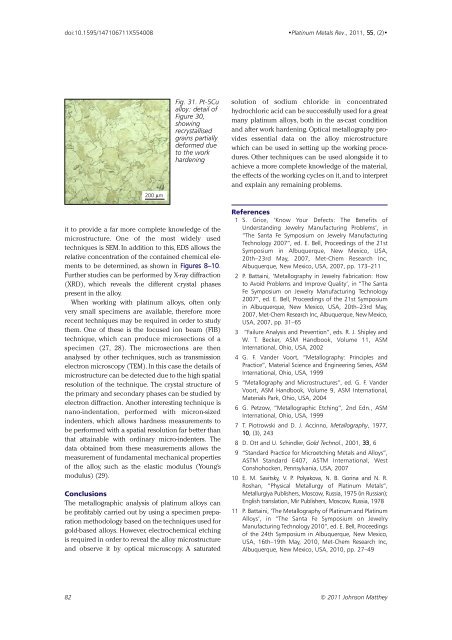Download - Platinum Metals Review
Download - Platinum Metals Review
Download - Platinum Metals Review
Create successful ePaper yourself
Turn your PDF publications into a flip-book with our unique Google optimized e-Paper software.
doi:10.1595/147106711X554008<br />
•<strong>Platinum</strong> <strong>Metals</strong> Rev., 2011, 55, (2)•<br />
200 µm<br />
Fig. 31. Pt-5Cu<br />
alloy: detail of<br />
Figure 30,<br />
showing<br />
recrystallised<br />
grains partially<br />
deformed due<br />
to the work<br />
hardening<br />
solution of sodium chloride in concentrated<br />
hydrochloric acid can be successfully used for a great<br />
many platinum alloys, both in the as-cast condition<br />
and after work hardening. Optical metallography provides<br />
essential data on the alloy microstructure<br />
which can be used in setting up the working procedures.<br />
Other techniques can be used alongside it to<br />
achieve a more complete knowledge of the material,<br />
the effects of the working cycles on it, and to interpret<br />
and explain any remaining problems.<br />
it to provide a far more complete knowledge of the<br />
microstructure. One of the most widely used<br />
techniques is SEM. In addition to this, EDS allows the<br />
relative concentration of the contained chemical elements<br />
to be determined, as shown in Figures 8–10.<br />
Further studies can be performed by X-ray diffraction<br />
(XRD), which reveals the different crystal phases<br />
present in the alloy.<br />
When working with platinum alloys, often only<br />
very small specimens are available, therefore more<br />
recent techniques may be required in order to study<br />
them. One of these is the focused ion beam (FIB)<br />
technique, which can produce microsections of a<br />
specimen (27, 28). The microsections are then<br />
analysed by other techniques, such as transmission<br />
electron microscopy (TEM). In this case the details of<br />
microstructure can be detected due to the high spatial<br />
resolution of the technique. The crystal structure of<br />
the primary and secondary phases can be studied by<br />
electron diffraction. Another interesting technique is<br />
nano-indentation, performed with micron-sized<br />
indenters, which allows hardness measurements to<br />
be performed with a spatial resolution far better than<br />
that attainable with ordinary micro-indenters. The<br />
data obtained from these measurements allows the<br />
measurement of fundamental mechanical properties<br />
of the alloy, such as the elastic modulus (Young’s<br />
modulus) (29).<br />
Conclusions<br />
The metallographic analysis of platinum alloys can<br />
be profitably carried out by using a specimen preparation<br />
methodology based on the techniques used for<br />
gold-based alloys. However, electrochemical etching<br />
is required in order to reveal the alloy microstructure<br />
and observe it by optical microscopy. A saturated<br />
References<br />
1 S. Grice, ‘Know Your Defects: The Benefits of<br />
Understanding Jewelry Manufacturing Problems’, in<br />
“The Santa Fe Symposium on Jewelry Manufacturing<br />
Technology 2007”, ed. E. Bell, Proceedings of the 21st<br />
Symposium in Albuquerque, New Mexico, USA,<br />
20th–23rd May, 2007, Met-Chem Research Inc,<br />
Albuquerque, New Mexico, USA, 2007, pp. 173–211<br />
2 P. Battaini, ‘Metallography in Jewelry Fabrication: How<br />
to Avoid Problems and Improve Quality’, in “The Santa<br />
Fe Symposium on Jewelry Manufacturing Technology<br />
2007”, ed. E. Bell, Proceedings of the 21st Symposium<br />
in Albuquerque, New Mexico, USA, 20th–23rd May,<br />
2007, Met-Chem Research Inc, Albuquerque, New Mexico,<br />
USA, 2007, pp. 31–65<br />
3 “Failure Analysis and Prevention”, eds. R. J. Shipley and<br />
W. T. Becker, ASM Handbook, Volume 11, ASM<br />
International, Ohio, USA, 2002<br />
4 G. F. Vander Voort, “Metallography: Principles and<br />
Practice”, Material Science and Engineering Series, ASM<br />
International, Ohio, USA, 1999<br />
5 “Metallography and Microstructures”, ed. G. F. Vander<br />
Voort, ASM Handbook, Volume 9, ASM International,<br />
Materials Park, Ohio, USA, 2004<br />
6 G. Petzow, “Metallographic Etching”, 2nd Edn., ASM<br />
International, Ohio, USA, 1999<br />
7 T. Piotrowski and D. J. Accinno, Metallography, 1977,<br />
10, (3), 243<br />
8 D. Ott and U. Schindler, Gold Technol., 2001, 33, 6<br />
9 “Standard Practice for Microetching <strong>Metals</strong> and Alloys”,<br />
ASTM Standard E407, ASTM International, West<br />
Conshohocken, Pennsylvania, USA, 2007<br />
10 E. M. Savitsky, V. P. Polyakova, N. B. Gorina and N. R.<br />
Roshan, “Physical Metallurgy of <strong>Platinum</strong> <strong>Metals</strong>”,<br />
Metallurgiya Publishers, Moscow, Russia, 1975 (in Russian);<br />
English translation, Mir Publishers, Moscow, Russia, 1978<br />
11 P. Battaini, ‘The Metallography of <strong>Platinum</strong> and <strong>Platinum</strong><br />
Alloys’, in “The Santa Fe Symposium on Jewelry<br />
Manufacturing Technology 2010”, ed. E. Bell, Proceedings<br />
of the 24th Symposium in Albuquerque, New Mexico,<br />
USA, 16th–19th May, 2010, Met-Chem Research Inc,<br />
Albuquerque, New Mexico, USA, 2010, pp. 27–49<br />
82 © 2011 Johnson Matthey
















